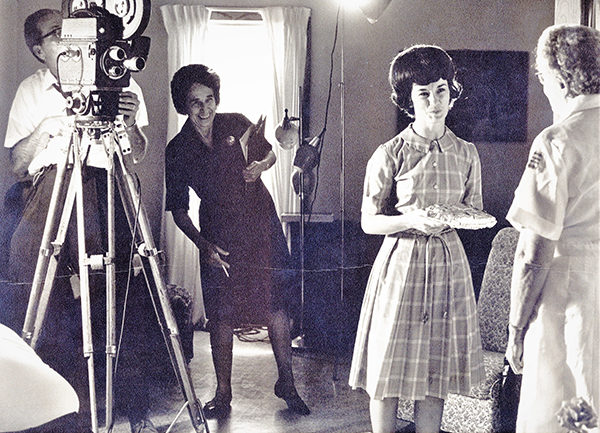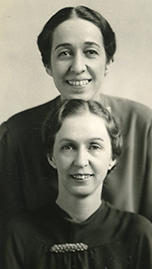Written by Stan Ingersol
From his column Past to Present

There was pushback when Rev. Mary Latham began producing films for the Church of the Nazarene. A segment of the church that opposed television also regarded motion pictures as a nexus of evil. The church used filmstrips in the Christian education program, but Mary wanted to add motion pictures. Looking back, she told this writer that the reactionary group “thought the devil lived in celluloid,” adding, “I was pretty sure he didn’t.”
Mary was one of seven children born to Rev. L. L. Latham and his wife Eugenia. They were a Louisiana family, and her siblings were born in Shreveport, but Mary was born in Cincinnati while her father was attending God’s Bible School.
The Latham family swung into the Church of the Nazarene when Mary was still young. Her father became noted for his interest in church architecture and the ability to lead churches through successful construction projects.
Three of Mary’s brothers died in infancy, but William P. Latham survived. He studied music in Cincinnati and became a well-known college music professor who composed symphonies, sacred music, and marches. He retired from the University of North Texas College of Music.
L. L. Latham considered Asbury College the best holiness school for his daughters. All three trained to be teachers there. Ruby specialized in languages and ended her career as a French professor at Bethany Nazarene College. Joy studied music at the Cincinnati Conservatory of Music and taught for a few years. Mary taught Latin and math in Kentucky schools for a time.
Early in their adult lives, though, Mary and Joy felt called to follow their father into the ministry. Joy was credentialed as a song evangelist, and general superintendent R. T. Williams ordained Mary as an elder in 1937 on the Kentucky-West Virginia District.
Billed as “The Latham Sisters,” Mary and Joy conducted revival meetings from church to church with an emphasis on reaching children. They concluded that visual aids were useful in speaking to youth, and Mary, an accomplished artist since high school, began creating chalk drawings during services.
The sisters evolved into Christian education specialists. In addition to revivals, they began conducting seminars focused on developing local children’s ministries.
In 1948, Mary was invited to join the Department of Church Schools as director of the Vacation Bible School (VBS) program. Under the arrangement, she worked at the Nazarene Headquarters a half-year and held revival meetings the other half. Her VBS work involved curriculum development and VBS promotion. In the next 20 years, sales of VBS workbooks jumped from under 60,000 a year to nearly 347,000.

Mary (top) and Joy
Mary’s interest in film grew out of her ministry to children. One of her first audio-visual mediums was filmstrips, but Mary recognized the advent of the television age was revolutionizing communications. Not only was entertainment changing; so was education.
The National Council of Churches formed in 1950. Mary developed a relationship with its Radio, Visual Education, and Communications Committee. She became adept in new visual arts and techniques, and she interacted with counterparts in other denominations as together they adapted to a communications revolution that was changing the world.
The vehicle for the Nazarenes was called NAVCO—Nazarene AudioVisual Committee—founded in 1962 with Mary Latham as director. By 1968, it was her full-time role and she led it until 1975.
She had already developed filmstrips and slide shows, now she moved into film. “The Great Transition,” an early film, was about Nazarene colleges and their students. “To Make a Miracle” (1972) and “The Alabaster Story” (1974) focused on Nazarene missions. Other films centered on Christian education, home missions, and the Nazarene Publishing House (NPH). She produced at least one film a year, sometimes several, and churches could purchase or rent them through NPH.
Charles Paddock was one of her early co-workers. He was interested in film production, and she bought him a camera and equipment. They worked together for years, and Paddock Productions is still in business, carried on by Charles’ son and grandsons. Others whom Mary mentored became employees of Media International, the Nazarene Headquarters office that succeeded NAVCO.
Mary Latham retired at age 70, but lived another 25 years. She started Latham Communications and continued producing visual media, including a film about general superintendent R. T. Williams.
Additionally, she performed another service for the denomination. Williams was converted and professed entire sanctification in the New Hope Methodist Church in Many, Louisiana. Mary had family connections to this church, and when she learned they were preparing a new building, she helped to secure the old building’s altar rail where Williams had knelt. It was placed in a prayer room at the Nazarene Headquarters and, for over a half-century, has been taken to General Assembly meetings where it is used in the induction ceremony of newly-elected general superintendents.
Mary died in Kansas City on April 12, 2000. She was buried with her parents and sisters in Forest Park East Cemetery in Shreveport, LA.
Dr. Stan Ingersol, Ph.D., is former manager of the Nazarene Archives.
